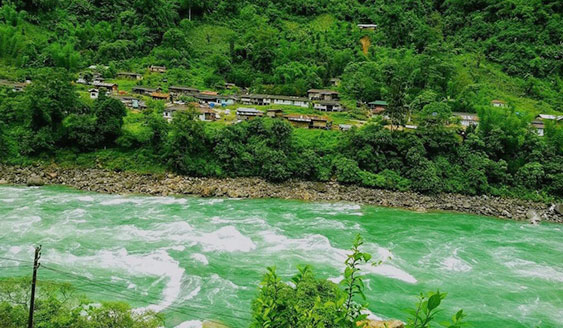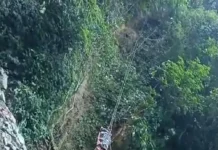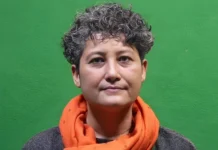
[ Karyir Riba & Tongam Rina ]
ITANAGAR, May 3: Rohit Mele, a native of Etalin in Dibang Valley district, where the Jindals’ 3,097 mw Etalin Hydroelectric Project (EHP) is slated to come up, says that he is not able to figure out the sudden protests against the project.
The project is being executed through a joint venture of the Jindal Power Ltd’s EHEPCL (74 percent) and the Hydro Power Development Corporation of Arunachal Pradesh Ltd (26 percent). The latter is a state government undertaking.
As reported earlier by this daily, the processes of the studies conducted and the clearances granted have been more than dubious – they were preposterous.
Chief advisor to the project-affected forum of the EHP, Mele says that the all-important public hearing was held “without any protest” on 12 December, 2014.
“Where were these people who are protesting now?” he asks.
“For any development project in an area, the consent of the local people is most important, and we have given our consent,” he says.
Mele says that those opposing the project because of environment concerns should have informed the people prior to the land acquisition process, instead of disturbing the project now.
Mele’s village community land is affected by the project. “Even though there has been no work on the Etalin project, more than 100 people are employed by the Jindals. We want to be part of the development process and we want to contribute to the growth of the state by allowing the hydroelectric project,” he says.
Ngasi Mena, a representative of the families that will be affected by the EHP, says that all those who are opposing the project are either those who are not affected by the project, or are complete outsiders.
Apart from all the technical issues, Mena says, if the project were to be scrapped now, hundreds of the project-affected families would suffer.
“Currently, at least 200 people from the affected families are employed by the developer company. In a place where 95 percent families are below the poverty line, even one family member that earns is very important.
“I want to ask the protesting people: who will contain this unemployment and who will provide them with a livelihood to take care of their families?” says Mena.
Mena adds that the project-affected people would welcome any fact-finding team to study the project closely and check if it is a boon or a bane for the people of the valley.
This daily is not able to authenticate the number of people employed as repeated calls and messages to the Jindals went unanswered.
‘After selling our land to corporates, where will we go? Where will we buy oxygen?’
Anoko Mega, a grassroots conservationist working on Hoolock gibbons in neighbouring Lower Dibang Valley district, does not share the enthusiasm of those who support the project.
He says that there is no reason why there should be so many dams on one basin. “Where will we go after selling our land? Where will we buy oxygen? Why should we sell ourselves to the corporates?” he asks.
“Indigenous communities have always been exploited by the powerful,” he says.
He fears that the pressure on the valley would be enormous. “Mishmis are few, and the impact of the hydropower on the community will be devastating,” he says.
Mega says that environment is a global issue; it is not only about Dibang valley. He says that even those who are in favour of the project should listen to the scientists and researchers who are experts in the field.
He further says that there has been no voice of dissent from the valley because they are demoralized. “We all know what happened with the Dibang hydropower project,” he says.
A resistance crushed in neighbouring district
The Centre had approved the 2880 mw Dibang Multipurpose Project (DMP), paving way for the construction of the world’s tallest concrete gravity dam at a staggering 278 metres on the Dibang river by the National Hydroelectric Power Corporation (NHPC) without the final forest clearance in July 2019.
The Mishmi community in Lower Dibang Valley stood up against the might of the government while opposing the DMP. The opposition was brutality crushed by the state, using police force and coercion.
Before the clearance was granted on 19 February, 2015, by the union ministry of environment, forests & climate change (MoEFCC), the project had witnessed massive protests by the local people, which had led to multiple postponements of public hearings. The public hearings were postponed several times between 2008 and 2013 due to stiff protests by the Mishmi community.
Controversially, most of the public hearings cancelled were blamed on bad weather conditions. Finally, two public hearings were held in the first quarter of 2013 for Lower Dibang Valley and Dibang Valley districts, where the public was reported to have agreed to the project.
According to studies, 115 families of five villages are likely to be displaced, and 744 families of 39 villages are likely o be affected due to acquisition of land.
Jindals’ impeccable PR job and curse on a small community
Most of the people this daily spoke to did not want their names made public, as they fear reprisals from community members.
“The Jindals did a very good PR job. The moment they got the Etalin project, they involved so many of the community members, gave them jobs and contract works and hired cars. Managerial jobs have been given, which we have never seen in other projects in the state,” a person says.
“In our state, project proponents give contractual jobs in Group D,” the person says.
Another one says that Mishmi villages have very small populations and most of the educated ones have homes away from their villages, so they are not bothered about those who will be left in the villages.
“Go to the villages and talk to people,” the person says, stating that most people who are directly set to lose their homestead have not been heard either by the press, the pro-dam proponents, the Jindals, or the state.
Another person makes a serious allegation against the state. “Because the Mishmi community is so small, nobody would have heard our voices. This empowers the state to overlook the environmental concerns, even though the entire Mishmi Hills is known for biodiversity.
“Why did the state government refuse a dam on the Siang even though the Centre was very keen to have one in the Siang valley?” the person says. “The chief minister himself refused to entertain the Centre’s proposal because he does not want to upset larger communities. The same happened in Tawang. The state succumbed to people’s resistance in Tawang – because they have the numbers. What is the point of putting up a resistance when we will not be heard by the state or its people?”
In December 2017, Chief Minister Pema Khandu had said that the state government would not accept the NITI Aayog’s proposal for building a 10,000 mw dam on the Siang river in Upper Siang district. He had said no other dams would be built on the Siang river “unless the confidence of the local people has been taken.”
Questionable deals and hurried virtual meetings
As reported earlier by this daily, the Wildlife Institute of India (WII) spent only four months on field while compiling a multi-seasonal replicate study on the Jindals’ Etalin project, and it relied on earlier studies conducted in the region.
The forest advisory committee (FAC) of the MoEFCC and the ministry itself did not bother to ask any questions as to how the study was compiled, even though one of its own reports states that four months’ study was carried out.
Instead, the FAC formed a subcommittee to look into the “concerns related to tree enumeration process and the aspects highlighted in biodiversity assessments study by WII.”
The wildlife study done by the WII is accepted in toto by the subcommittee, the subcommittee report says.
The subcommittee included a member of the WII who was part of the team that cheated its way to compile a questionable report on Etalin.
The FAC in its meeting held on 28 February, 2017, had suggested “multi-seasonal replicate studies on biodiversity assessment as the current environment impact assessment is completely inadequate.”
Arunachal’s forest department wrote to the WII, requesting for the study, on 23 June, 2017, stating that “all expenditure in the respect of the study shall be borne by the user agency, ie, M/s Etalin HEP Company Ltd (EHEPCL), Gurgaon.”
An MoU was subsequently signed between the WII and the EHEPCL on 22 November, 2017.
The MoU “provides broad understanding to mutually engage into the specific assignment based on the needs of the EHEPCL. Whenever solicited, WII shall render its expertise in the best possible manner as per the needs of the EHEPCL at mutually agreed commercial terms.”
The FAC virtually reviewed the project on 23 April. Details are awaited as to what decision the FAC took, but the subcommittee report was not made public for comments or recommendations.
Questions from the experts
Drs Aparajita Datta, Anindya Sinham, Nandini Velho and Umesh Srinivasan have written to the FAC to assess the cumulative ecological impacts of the project before clearing it. (See letter.)
They asked the FAC to consider the global uniqueness and value of this land, as well as India’s international commitment to the protection of globally important forests and biodiversity.
“Across government and non-government institutions, there is unequivocal evidence of the local, regional, national and global uniqueness of Dibang Valley. We are at the juncture where it is possible to put forth an exemplary partnership-based Idu Mishmi model of wildlife conservation, not only for Arunachal Pradesh, but as an example for the entire country and the world to follow. We implore you to choose this option. India can once again lead the world as a true ecological champion in this time of unprecedented social and ecological crisis,” the letter read.
They wrote that “there must be a cumulative assessment of the biodiversity impacts of multiple hydropower projects planned in the Dibang basin. Most notable of these are India’s two biggest projects – the 3097 mw Etalin and the 2880 me Dibang multipurpose project. The impacts of multiple projects placed in close proximity on the same river limb must be assessed together, because these impacts will be cumulative and not independent. This applies in particular to the breaking up of the 3097 mw Etalin project and the 22 mw Anonpani project as separate diversion proposals.”



